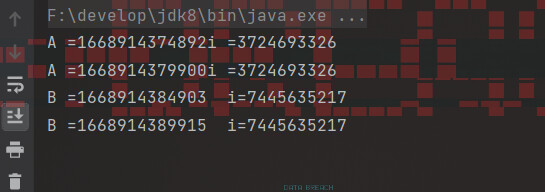多线程基础技术
1.1 进程与多线程
1、进程
程序由指令和数据组成,但这些指令要运行,数据要读写,就必须将指令加载至 CPU,数据加载至内存。在 指令运行过程中还需要用到磁盘、网络等设备。进程就是用来加载指令、管理内存、管理 IO 的 当一个程序被运行,从磁盘加载这个程序的代码至内存,这时就开启了一个进程。 进程就可以视为程序的一个实例。大部分程序可以同时运行多个实例进程(例如记事本、画图、浏览器 等),也有的程序只能启动一个实例进程(例如网易云音乐、360 安全卫士等)
2、那什么是线程呢?
线程可以理解成是在进程中独立运行的子任务。比如,QQ.exe 运行时就有很多的子任务在同时运行。再如,好友视频线程、下载文件线程、传输数据线程、发送表情线程等,这些不同的任务或者说功能都可以同时运行,其中每一项任务完全可以理解成是“线程”在工作,传文件、听音乐、发送图片表情等功能都有对应的线程在后台默默地运行。这样做有什么优点呢?更具体来讲,使用多线程有什么优点呢?其实如果读者有使用“多任务操作系统”的经验,比如 Windows 系列,那么它的方便性大家应该都有体会:使用多任务操作系统 Windows后,可以最大限度地利用CPU的空闲时间来处理其他的任务,比如一边让操作系统处理正在由打印机打印的数据,一边使用 Word 编辑文档。而CPU在这些任务之间不停地切换,由于切换的速度非常快,给使用者的感受就是这些任务似乎在同时运行。所以使用多线程技术后,可以在同一时间内运行更多不同种类的任务
3、多线程优点(为什么使用多线程):
普及概念:
以调用方角度来讲,如果 需要等待结果返回,才能继续运行就是同步
不需要等待结果返回,就能继续运行就是异步

在图中可以发现,CPU 完全可以在任务1和任务2之间来切换,使任务2不必等到10秒再运行,系统的运行效率大大得到提升。这就是要使用多线程技术、要学习多线程的原因。这是多线程技术的优点,使用多线程也就是在使用异步。
1.2、多线程的使用
1.2.1继承Thread类
1 | |
从上面的源代码中可以发现,Thread类实现了 Runnable 接口,它们之间具有多态关系其实,使用继承Thread类的方式创建新线程时,最大的局限就是不支持多继承,因为Java语言的特点就是单根继承,所以为了支持多继承,完全可以实现 Runnable 接口的方式边实现一边继承。但用这两种方式创建的线程在工作时的性质是一样的,没有本质的区别
1 | |

从图的运行结果来看,MyThread.java类中的run 方法执行的时间比较晚,这也说明在使用多线程技术时,代码的运行结果与代码执行顺序或调用顺序是无关的。
线程是一个子任务,CPU 以不确定的方式,或者说是以随机的时间来调用线程中的run方法,所以就会出现先打印“运行结束!”后输出“MyThread”这样的结果了。
两个小问题:
为什么要重写run()方法?
因为run()是用来封装被线程执行的代码
run()方法和start()方法的区别?
run():封装线程执行的代码,直接调用,相当于普通方法的调用
start():启动线程;然后由JVM调用此线程的run()方法
1.2.2 实现Runnable 接口
如果欲创建的线程类已经有一个父类了,这时就不能再继承自Thread类了,因为Java不支持多继承,所以就需要实现 Runnable 接口来应对这样的情况。
1 | |

使用继承 Thread类的方式来开发多线程应用程序在设计上是有局限性的,因为 Java 是单根继承,不支持多继承,所以为了改变这种限制,可以使用实现 Runnable 接口的方式来实现多线程技术。 Thread(Runnable target)不光可以传人 Runnable接口的对象,还可以传人一个Thread类的对象,这样做完全可以将一个Thread 对象中的run0方法交由其他的线程进行调用。
实现Runnable接口 VS 继承 Thread
实现接口会更好一些,因为:
- Java 不支持多重继承,因此继承了 Thread 类就无法继承其它类,但是可以实现多个接口;
- 类可能只要求可执行就行,继承整个 Thread 类开销过大。
1.2.3实现多线程方式三: 实现Callable接口
实现步骤
- 定义一个类MyCallable实现Callable接口
- 在MyCallable类中重写call()方法
- 创建MyCallable类的对象
- 创建Future的实现类FutureTask对象,把MyCallable对象作为构造方法的参数
- 创建Thread类的对象,把FutureTask对象作为构造方法的参数
- 启动线程
- 再调用get方法,就可以获取线程结束之后的结果。
代码:
1 | |

三种实现方式的对比
实现Runnable、Callable接口
好处: 扩展性强,实现该接口的同时还可以继承其他的类
缺点: 编程相对复杂,不能直接使用Thread类中的方法
继承Thread类
好处: 编程比较简单,可以直接使用Thread类中的方法
缺点: 可以扩展性较差,不能再继承其他的类

1.2.4实例变量与线程安全
自定义线程类中的实例变量针对其他线程可以有共享与不共享之分,这在多个线程之间进行交互时是很重要的一个技术点。
(1)不共享数据模型

1 | |
不共享数据运行结果如图所示

由图可以看到,一共创建了3个线程,每个线程都有各自的count 变量,自己减少自己的count变量的值。这样的情况就是变量不共享,此示例并不存在多个线程访问同一个实例变量的情况。
如果想实现3个线程共同对一个count 变量进行减法操作的目的,该如何设计代码呢?
(2)共享数据的情况

共享数据的情况就是多个线程可以访问同一个变量,比如在实现投票功能的软件时,多个线程可以同时处理同一个人的票数
下面通过一个示例来看下数据共享情况。
测试案例:
1 | |

从结果可以看到,线程A和B打印出的count值都是3,说明A和B同时对count 进行处理,产生了“非线程安全”问题。而我们想要得到的打印结果却不是重复的,而是依次递减的在某些JVM 中,i–的操作要分成如下3步
1)取得原有i值
2)计算 i-1。
3)对进行赋值
在这3个步骤中,如果有多个线程同时访问,那么一定会出现非线程安全问题
1.3 currentThread()方法
方法介绍
方法名 说明 void setName(String name) 将此线程的名称更改为等于参数name String getName() 返回此线程的名称 Thread currentThread() 返回对当前正在执行的线程对象的引用 currentThread0方法可返回代码段正在被哪个线程调用的信息。下面通过一个示例进行说明。
创建项目,创建代码如下:1
2
3
4
5public class t6 {
public static void main(String[] args) {
System.out.println(Thread.currentThread().getName());
}
}代码演示
1
2
3
4
5
6
7
8
9
10
11
12
13
14
15
16
17
18
19
20
21
22
23
24
25
26
27
28
29
30
31
32
33public class MyThread extends Thread {
public MyThread() {}
public MyThread(String name) {
super(name);
}
@Override
public void run() {
for (int i = 0; i < 100; i++) {
System.out.println(getName()+":"+i);
}
}
}
public class MyThreadDemo {
public static void main(String[] args) {
MyThread my1 = new MyThread();
MyThread my2 = new MyThread();
//void setName(String name):将此线程的名称更改为等于参数 name
my1.setName("高铁");
my2.setName("飞机");
//Thread(String name)
MyThread my1 = new MyThread("高铁");
MyThread my2 = new MyThread("飞机");
my1.start();
my2.start();
//static Thread currentThread() 返回对当前正在执行的线程对象的引用
System.out.println(Thread.currentThread().getName());
}
}
1.4 isAlive()方法
方法isAlive0)的功能是判断当前的线程是否处于活动状态新建项目t7,类文件代码如下
1 | |

1.5 线程休眠
static void sleep(long millis) 使当前正在执行的线程停留(暂停执行)指定的毫秒数 代码演示
1
2
3
4
5
6
7
8
9
10
11
12
13
14
15
16
17
18
19
20
21
22
23
24
25
26
27
28
29public class MyRunnable implements Runnable {
@Override
public void run() {
for (int i = 0; i < 100; i++) {
try {
Thread.sleep(100);
} catch (InterruptedException e) {
e.printStackTrace();
}
System.out.println(Thread.currentThread().getName() + "---" + i);
}
}
}
public class Demo {
public static void main(String[] args) throws InterruptedException {
/*System.out.println("睡觉前");
Thread.sleep(3000);
System.out.println("睡醒了");*/
MyRunnable mr = new MyRunnable();
Thread t1 = new Thread(mr);
Thread t2 = new Thread(mr);
t1.start();
t2.start();
}
}
1.6 getId()方法
getId0方法的作用是取得线程的唯一标识。创建测试用的项目runThread,创建Test,java类,代码
1 | |

1.7 线程停止
大多数停止个线程的操作使用Thread.interrupt0方法,尽管方法的名称是“停止,中止”的意思,但这个方法不会终止一个正在运行的线程,还需要加人一个判断才可以完成线程的停止。关于此知识点在后面有专门的章节进行介绍。
在Java中有以下3种方法可以终止正在运行的线:
1)使用退出标志,使线程正常退出,也就是当run 方法完成后线程终止。
2)使用stop 方法强行终止线程,但是不推荐使用这个方法,因为stop 和suspend 及resume一样,都是作废过期的方法,使用它们可能产生不可预料的结果。
3)使用interrupt 方法中断线程。
本示例将调用interrupt0方法来停止线程,但interrupt0)方法的使用效果并不像for+break 语句那样,马上就停止循环。调用interrupt0方法仅仅是在当前线程中打了一个停止的标记,并不是真的停止线程。
1.7.1 interrupt()–停止标记
本示例将调用interrupt0方法来停止线程,但interrupt0方法的使用效果并不像for+break语句那样,马上就停止循环。调用interrupt0)方法仅仅是在当前线程中打了一个停止的标记,并不是真的停止线程。
1 | |

从运行的结果来看,调用interrupt 方法并没有停止线程。如何停止线程呢?
Java的SDK中,Threadjava类里提供了两种方法
1)this.interrupted():测试当前线程是否已经中断。
2)this.isInterrupted():测试线程是否已经中断。
下面通过代码比较两个方法
1)interrupted()
1 | |

来判断 thread 对象所代表的线程是否停止,但从控制台打印的结果来看,线程并未停止,这也就证明了interrupted0 方法的解释:测试当前线程是否已经中断。这个“当前线程是main,它从未中断过,所以打印的结果是两个 false。
如何在main线程中产生效果?
修改代码:
1 | |

为什么第2个布尔值是false呢?查看一下官方帮助文档中对interrupted 方法的解释
测试当前线程是否已经中断。线程的中断状态由该方法清除。换句话说,如果连续两次调用该方法,则第二次调用将返回 false (在第一次调用已清除了其中断状态之后,且第二次调用检验完中断状态前,当前线程再次中断的情况除外)。
文档已经解释得很详细interrupted0方法具有清除状态的功能,所以第2次调用interrupted0方法返回的值是false。
2)isInterrupted():
1 | |

从结果中可以看到,方法isInterrupted0并未清除状态标志,所以打印了两个 true。
最后,再来看一下这两个方法的解释
1)this.interrupted():测试当前线程是否已经是中断状态执行后具有将状态标志置清除为 false 的功能。
2)this.isInterrupted():测试线程Thread 对象是否已经是中断状态,但不清除状态标志。
1.7.2 异常法停止线程
在线程中用for语句来判断一下线程是否是停止状态,但如果 for 语句下面还有语句,还是会继续运行的。
所以
1 | |

1.7.3在线程sleep()中停止
如果线程在sleep0状态下停止线程,会是什么效果呢?
1 | |

从打印的结果来看,如果在 sleep 状态下停止某一线程,会进人 cath 语句,并且清除停止状态值,使之变成 false。前一个实验是先sleep 然后再用interrupt0停止,与之相反的操作在学习线程时也要注意。
1.7.4 stop()—暴力停止
使用stop0方法停止线程则是非常暴力的
1 | |

线程被暴力停止(stop)运行后图标呈灰色
1.8暂停线程
1.8.1suspend与resume方法的使用
暂停线程意味着此线程还可以恢复运行。在Java 多线程中,可以使用suspend()方法暂停线程,使用resume()方法恢复线程的执行。
1 | |

从控制台打印的时间上来看,线程的确被暂停了,而且还可以恢复成运行的状态。
1.8.2 suspend 与resume 方法的缺点-独占(死锁)
在使用suspend与resume 方法时,如果使用不当,极易造成公共的同步对象的独占(死锁),使得其他线程无法访问公共同步对象。
1 | |
1 | |
独占锁死了 printString方法
1.8.3 suspend与resume 方法的缺点一不同步
在使用suspend与resume方法时也容易出现因为线程的暂停而导致数据不同步的情况
1 | |
1 | |
程序运行的结果出现值不同步的情况,所以在程序中使用 suspend()方法要格外注意关于如何解决这些问题,请看后面的章节。
1.9线程优先级【应用】
线程调度
两种调度方式
- 分时调度模型:所有线程轮流使用 CPU 的使用权,平均分配每个线程占用 CPU 的时间片
- 抢占式调度模型:优先让优先级高的线程使用 CPU,如果线程的优先级相同,那么会随机选择一个,优先级高的线程获取的 CPU 时间片相对多一些
Java使用的是抢占式调度模型
随机性
假如计算机只有一个 CPU,那么 CPU 在某一个时刻只能执行一条指令,线程只有得到CPU时间片,也就是使用权,才可以执行指令。所以说多线程程序的执行是有随机性,因为谁抢到CPU的使用权是不一定的
优先级相关方法
方法名 说明 final int getPriority() 返回此线程的优先级 final void setPriority(int newPriority) 更改此线程的优先级线程默认优先级是5;线程优先级的范围是:1-10 代码演示
1
2
3
4
5
6
7
8
9
10
11
12
13
14
15
16
17
18
19
20
21
22
23
24
25
26
27
28
29
30
31
32
33public class MyCallable implements Callable<String> {
@Override
public String call() throws Exception {
for (int i = 0; i < 100; i++) {
System.out.println(Thread.currentThread().getName() + "---" + i);
}
return "线程执行完毕了";
}
}
public class Demo {
public static void main(String[] args) {
//优先级: 1 - 10 默认值:5
MyCallable mc = new MyCallable();
FutureTask<String> ft = new FutureTask<>(mc);
Thread t1 = new Thread(ft);
t1.setName("飞机");
t1.setPriority(10);
//System.out.println(t1.getPriority());//5
t1.start();
MyCallable mc2 = new MyCallable();
FutureTask<String> ft2 = new FutureTask<>(mc2);
Thread t2 = new Thread(ft2);
t2.setName("坦克");
t2.setPriority(1);
//System.out.println(t2.getPriority());//5
t2.start();
}
}

可见没有先后顺序,所以优先级在操作系统前并不好使!
1.7.6守护线程【应用】
相关方法
方法名 说明 void setDaemon(boolean on) 将此线程标记为守护线程,当运行的线程都是守护线程时,Java虚拟机将退出 代码演示!
1
2
3
4
5
6
7
8
9
10
11
12
13
14
15
16
17
18
19
20
21
22
23
24
25
26
27
28
29
30
31
32public class MyThread1 extends Thread {
@Override
public void run() {
for (int i = 0; i < 10; i++) {
System.out.println(getName() + "---" + i);
}
}
}
public class MyThread2 extends Thread {
@Override
public void run() {
for (int i = 0; i < 100; i++) {
System.out.println(getName() + "---" + i);
}
}
}
public class Demo {
public static void main(String[] args) {
MyThread1 t1 = new MyThread1();
MyThread2 t2 = new MyThread2();
t1.setName("女神");
t2.setName("备胎");
//把第二个线程设置为守护线程
//当普通线程执行完之后,那么守护线程也没有继续运行下去的必要了.
t2.setDaemon(true);
t1.start();
t2.start();
}
}

可见守护线程要等普通线程运行完再运行或者停止!
